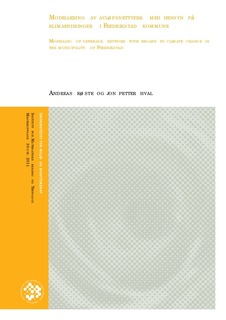| dc.description.abstract | This paper has looked into how climate change will affect the drainage system in Veumdalen,
Fredrikstad municipality. Veumdalen has been looked at as a whole, as well as a deeper analysis of
different subfields with buildings. A comparison with previous research has also been done towards
the end of the paper. Different 10-, 20- and 50-year rains have been constructed, in addition to a
percentage climate change which also has been added.
When it comes to the number of manholes with critical level (water level above 75 cm top pipe), a 10
year rainfall will lead to 12 cases of this. By adding 10 % to the rainfall intensity, the percentage rise
in number of manholes with critical level will be 17 %. In other words; the increase is greater than
the increase in rainfall intensity. The worst case happens when 50 % is added to the rainfall intensity.
This leads to an increase of 417 % in number of manholes above critical level. These analyses have
also been made for 20- and 50-year rains with similar conclusions.
For pipe lines with a pressure height above critical level (75 cm above the top of the pipe), a similar
analysis has been done. The total length of all the pipes which has reached the critical level has been
added together, to look at how the piping system holds up to an increase in rainfall intensity. The
tendencies are the same as for the manholes, were a percentage increase in rainfall intensity leads to
an even greater percentage increase in total length of pipes above critical level. In this case the
percentage increase is largest for a 10-year rainfall, with a whopping 367 % increase in pipe length
for 50 % added rainfall intensity.
It has also been done simulations that show the pipe networks performance in relation to “Norsk
Vann” recommended design requirements. Based on the results, 1.1 % of the pipelines do not meet
the requirement of maximum filling degree of 100 % once every ten years. Moreover, it also sets the
requirement of reaching the critical level only once per twenty years. 2.3 % of the distribution system
fails to meet these requirements.
When it comes to the amount of overflow a 10 year rainfall will increase the total amount from 1590
m3 to 2755 m3, when 50 % rainfall intensity is added. Again, the increase in percentage is greater
than the percentage increase in intensity. For a 50-year rainfall the total amount is 2409 m3 and
3949m3 respectively, in other words an increase of approximately 64 %.
Furthermore, the thesis dealt with different subfields, and looked at the number of buildings that in
some way could be connected to pipelines above critical level. The results from these areas are
summed together and presented in a separate chapter regarding the total number of affected
buildings. Here the results show that an increase of 50 % in rainfall intensity will cause an percentage
increase of affected buildings in the range of 133-226 %, depending on which return period is used.
This paper also contains results regarding subfields with a separate storm water pipe line. In these
areas we have looked at storm water which rises to the ground level, and start causing trouble for
the drainage around the houses and so forth. In the subfield named Myratoppen, five manholes will
have storm water which reaches the ground level. The height above the manhole top lies in the
range of 18-51 cm. In another subfield, namely “Veumdalen north-west, Ambjørnrød”, two manholes
have the same problem. These manholes flood 20 and 31 cm respectively above the top of the
manhole. Finally, the thesis has conducted a sensitivity analysis on the parameters “percentage contributing
dense area” and “runoff time”. Looking at an area which previously has been strongly affected by
basement flooding, the sensitivity was measured in relation to the change in maximum flow. The
results show that the model has greater sensitivity to the parameter “percentage contributing dense
area” than “runoff time”. | en_US |
